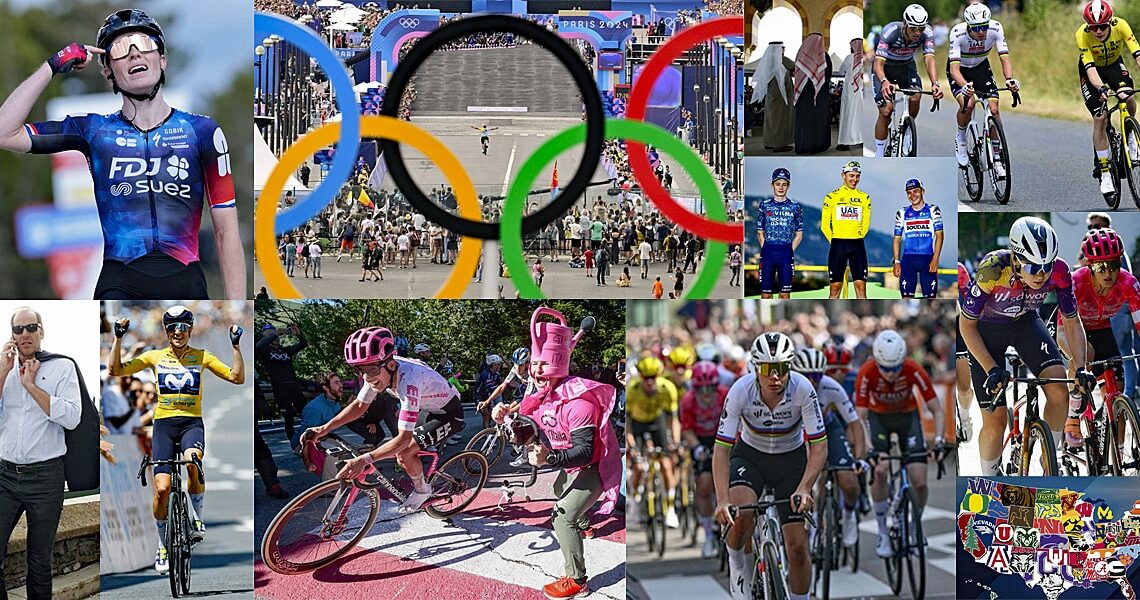
In this week’s AIRmail newsletter, The Outer Line takes an in-depth look at trending cycling news: “One Cycling” rejected, Dauphine as Tour predictor, is Pog making the sport boring? New stars in women’s racing, changing immigration policy impact on sports and reliance on individual stars ….
# Catch up on pro cycling – and its context within the broader world of sports – with AIRmail … Analysis, Insight and Reflections from The Outer Line. You can subscribe to AIRmail here, and check out The Outer Line’s extensive library of articles on the governance and economics of cycling here. #
Key Takeaways:
- One Cycling Project Rejected by UCI
- Dauphine as Tour Predictor?
- Is Pog Making the Sport Exciting, or Boring?
- New Stars are Emerging in WWT
- Changing Immigration Policies: Impact on Sports
- WWT: Risks of Reliance on Individual Stars

Saudi-backed “One Cycling” project: “incompatible and lacking sporting coherence”
Rumors and hearsay around the supposedly Saudi-backed “One Cycling” project have dominated the cycling media for almost two years now. Often described as constituting a transformative change for the sport that was imminent, or at least just around the corner, the whole project was dealt a potentially fatal blow this week when the UCI declared the project to be “incompatible and lacking sporting coherence.” Although the various parties involved are apparently committed to continuing discussions, this harsh assessment leads to serious questions about the longer-term viability of the concept. We have been supportive of the general premise and direction of the proposed project, and indeed have promoted many of the same ideas – as have others – for many years. However, after months and months of rampant speculation, this latest reform scheme seems to have run into the very same barriers and obstacles that virtually all other prior efforts to reform cycling have encountered, as well as perhaps a few additional challenges.

ASO not interested in change
Most critically – as is only too well-known to observers of cycling economics and governance – no plan, reform or structural change in cycling has much chance to proceed if it does not have the approval and support of Amaury Sport Organization (ASO). The family-owned French company controls the Tour de France and about half of the remaining top-level WorldTour men’s and women’s races. ASO clearly did not wish to see its dominance and control over the sport challenged or potentially diluted. As it has historically demonstrated, ASO invariably opts to maintain its “big piece of a small pie” approach rather than coordinating with others to help build the sport into a much bigger pie for all. This seemingly self-defeating stance has been the organization’s basic business position for decades – and constitutes the albatross draped around the sport’s shoulders. UCI President David Lappartient had earlier appeared to generally support the initiative but apparently changed his mind – or was perhaps pressured by ASO to adjust his position. Second, as has also been faced by all previous reformers, cycling is heavily dependent on outside sponsors for its financial livelihood, and does not currently have a business plan or revenue-generation system which meaningfully diversifies its financial sustainability. This undoubtedly frustrated the potential investors. Additionally in this case, the participating teams’ apparent inability to keep the existence and status of the discussions confidential probably spooked the investors, for whom discretion is often a key to dealmaking success. Where the project goes next is anyone’s guess, but we fear that it will either collapse altogether like the previous reform measures, or diminish into a marginal sidelight adjustment that doesn’t really change the sport’s overall landscape.

Pogačar dominant days in the Dauphiné Alps
At this past weekend’s traditional Tour de France dress rehearsal, the Critérium du Dauphiné, Tadej Pogačar reminded everyone why he is the defending Tour champion. The Rhône-Alpes regionally-centered French race is a dry run for the Tour’s biggest alpine mountain stages; hence, his performance was a huge shot across the bow for any other riders hoping to challenge him in July and created a sense of inevitability about the upcoming event. Despite a poor time-trial performance on stage four, he stormed back with three dominant days in the Alps to secure the victory. Pogačar romped through the eight-day race against the sport’s highest level of GC competition with ease, and even with that mid-race time trial wobble which cost him significant time, his eventual 59-second margin over runner-up Jonas Vingegaard and his more than three-minute advantage over to third-placed Remco Evenepoel barely describes his mastery of this edition. Although some are suggesting that perhaps he has peaked too soon, four other riders have won the Dauphine by 58 seconds or more since 2012 and all four have gone on to win the Tour de France a few weeks later (Wiggins, Froome, Thomas and Vingegaard).

Same again in 2025?
Pogačar’s performance once again raised the question of whether his dominance has increased the level of interest in the upcoming Tour de France, or decreased it by effectively eliminating any sense of competitiveness or intrigue. Of course, whatever the answer, this question is somewhat meaningless since there is nothing to be done to solve the “Pog” riddle. Additionally, it should be remembered that dynastic runs are part and parcel of cycling’s biggest race; only 17 unique riders have won the last 35 editions, with just three riders accounting for almost half of those yellow jerseys. Despite this, interest in the race actually peaked during those dynastic yet monotonous runs. While fans will often claim they prefer parity, the hard numbers tend to run counter. For example, since the NBA implemented financial restrictions essentially making it impossible to build dynasties, the league hasn’t seen a repeat winner, and ratings have declined. We are reminded of an oft-repeated parable about the Tour de France that can be applied to many other sports: the public wants to see the race’s winner suffer to earn victory. As with challengers to Merckx, Hinault, Indurain, and Armstrong, the spectacle and broadcast interest was generated by riders attempting to defeat the race’s incumbent and dominant champion – whether they succeeded in usurping the king or died by the sword along the parcours.

level the playing field
In stark contrast to the heavily regulated American leagues, professional cycling is like the wild west, with a handful of the biggest teams hoarding all the talent and winning a vast majority of the biggest races. Jonathan Vaughters touched on this phenomenon in a recent wide-ranging interview with The Cycling Podcast’s Lionel Birnie, where he claimed that his EF Education-EasyPost team’s entire payroll was less than that of UAE’s eight-rider Giro d’Italia squad. While that is likely accurate, and while Vaughters’ general calls for leveling the playing field and modernizing the racing calendar are merited, as we have pointed out many times before, there is still a way for teams below the super-team tier to achieve success. For example, despite not having any superstars, XDS-Astana is currently ranked 4th in the UCI Team Points Rankings and is one of the strongest teams in any race in which they take part. Alpecin-Deceunick, through an extremely top-heavy and focused team-building strategy, has won seven Monuments in the last three seasons while having a very pedestrian total team payroll.

Marlen Reusser controlled the Tour de Suisse Women 2025
Two women’s pro stage races concluded on Sunday, with the increasingly important Tour de Suisse wrapping up its ninth edition prior to the start of the men’s race, and the fourth edition of the Tour Féminin International des Pyrénées finishing in Pau (FR). In Switzerland, Marlen Reusser of Movistar took a hometown GC victory along with two stage wins and emphatically demonstrated her qualities as both the leader of her team and her emergence as a legitimate Tour de France Femmes contender. Two key moments of her overall win represented physical and psychological victories over her key rival in the race – the key rival for every woman racing in the WWT – FDJ’s Demi Vollering. On stage 1, Reusser unleashed a powerful sustained sprint to outlast Vollering for the win after both riders buoyed a long breakaway to open the race. But Reusser’s more important trophy may have been earned psychologically during stage 2, when she held Vollering in check while other contenders like Kasia Nieuwiadoma took time from them up the road. Reusser’s team – weaker than those of many other star riders – meant that she had to essentially defend alone while Vollering’s teammate Amber Kraak took that stage win. But she overcame tactical frustration to not only defend in stage 3 but confidently ride away from Vollering to take stage four and seal the overall. Given that many of the top women present in Switzerland are building for the TdFF, Reusser’s win cannot be taken lightly: with victories in Itzulia and in her home tour, the time trial specialist has fully emerged from the shadow of her former SDWorx teammates to become a legitimate contender.

Vollering couldn’t beat Reusser in Switzerland
The Pro-level International des Pyrénées was a notch below Switzerland’s WWT caliber field and notable for Ally Wollaston’s stage 1 win – her third victory of the year for FDJ, following a surprise overall win at the Tour of Britain last week and the Great Ocean race to start the 2025 WWT. The race, won by Usoa Ostolaza of the regional Laboral Kutxa – Fundación Euskadi team, is woven into an expanding fabric of women’s racing development that provides smaller teams and younger riders with more experience against seasoned WWT riders without “throwing them to the wolves” in the bigger WWT events. This oft-leveled criticism of women’s pro racing since the UCI relaunched the WWT – that the disparate talent, skill, and preparation of the small teams created safety risks and devalued the broadcast product – is slowly being polished away as more events create opportunities for the peloton to “level-up.” More importantly, races like these could become invaluable as national federations tackle talent development pipeline deficiencies to sustain the peloton and bring forward the next wave of stars.

Problems for the FIFA World Cup and the Olympic Games
Without trying to parse the morass of politics behind it, U.S. travel bans leveled against 12 countries, with a further 36 under consideration, have the potential to derail the economics of the 2026 FIFA World Cup and the 2028 Los Angeles Olympics. Both events are going to convene a diverse mix of nations and athletes, and will require participants, their entourages, fans and journalists to stay in the host country for up to a month – or longer, especially for athletes preparing on site for the competition. But with U.S. visas becoming much more restrictive and constrained, and the likelihood that teams and fans will need to cross U.S. borders multiple times for World Cup matches scheduled to be played in Canada and Mexico, the financial impact of reduced sports tourism should not be underestimated. Already, travel and tourism to the U.S. during this period of immigration policy and foreign relations disruption has cratered, with steep drop-offs in visitation from nearly every European FIFA powerhouse nation, and an estimated loss of up to $90 billion in tourism revenues already. Whether or not the trend continues will be determined by possible modifications to current administration policies and other seasonal shifts in tourism consumer patterns. However, the potential decline in the biggest selling point for hosting the Olympics or World Cup – the economic boost to regional host cities – could be a shock to the system and upend global sporting economics for years to come.

NCAA – Very important
A parallel long-term impact of the travel and immigration upheaval could suppress talent development in global sports as fewer young athletes are able to travel to and reside in the U.S. to compete at the collegiate level. Currently, the NCAA is considered to be the most important component of the athletics/track and field talent ecosystem; athletes from all over the world are able to earn an education while training and competing at the highest level the sport can offer, just short of continental, world championships, or Champions league events. In many cases, these young athletes are simultaneously escaping poverty and unrest in their native countries. The globalization of basketball could make that sport an acute casualty — talented players not already developing in the European club system are playing for top U.S. schools in the hopes of earning Name/Image/Likeness rewards and the potential to be drafted into an NBA or WNBA-level franchise. In that same vein, U.S. cycling talent development and race development could be adversely impacted. Foremost, the travel restrictions could impact the visitation of foreign riders staying in the U.S. for extended periods to cover multiple events, which could in turn reduce the competitive level and tourism volume of key gravel races. Similarly, if other countries place retaliatory travel restrictions on U.S. citizens, it could increase the risks for cycling talent development programs which are increasingly reliant on European operations — those riders and staff could face shortened visitation durations, thus limiting competitive opportunities.

World Champion Lotte Kopecky
We recently noted the impact on viewership when a star woman athlete is out of competition, as evidenced by the WNBA’s Caitlin Clark missing three weeks due to injury. Just prior to returning to action on Saturday, the drop in viewership of her Indiana Fever team’s games dropped 53% below season average; much more significant, however, is the fact that overall WNBA national viewership dropped by 55%. The parallel to women’s cycling and other women’s sports like tennis is worth bearing in mind: it’s a hard sell for fans to invest time to watch a tennis tournament if only a few of the players are top-ranked, and likewise, WWT races which lack half the sport’s top riders aren’t going to achieve full broadcast potential. As noted, the Tour de Suisse featured many of the UCI’s top WWT riders, but SDWorx’s Anna van der Breggen and her World Champion teammate Lotte Kopecky – both of whom would have been serious contenders for victory – weren’t in the field. Clark is a generational anomaly in sport, akin to the Williams sisters in tennis for her ability to catalyze fan, media, and sponsor interest in her sport. Similarly, the rivalry of Vollering vs. her former SDWorx teammates, particularly Van der Breggen (and now Reusser), is an energy that the WWT must tap into while the riders are in their prime, or risk losing valuable momentum before the sport embeds into global cultural and sporting relevance.

Anna van der Breggen was missing
# Catch up on pro cycling – and its context within the broader world of sports – with AIRmail … Analysis, Insight and Reflections from The Outer Line. You can subscribe to AIRmail here, and check out The Outer Line’s extensive library of articles on the governance and economics of cycling here. #
The post ‘One Cycling’ Rejected, Dauphine Tour Predictor, Pog Boring? Women’s Racing Stars, Immigration Policy & Reliance On Stars appeared first on PezCycling News.




